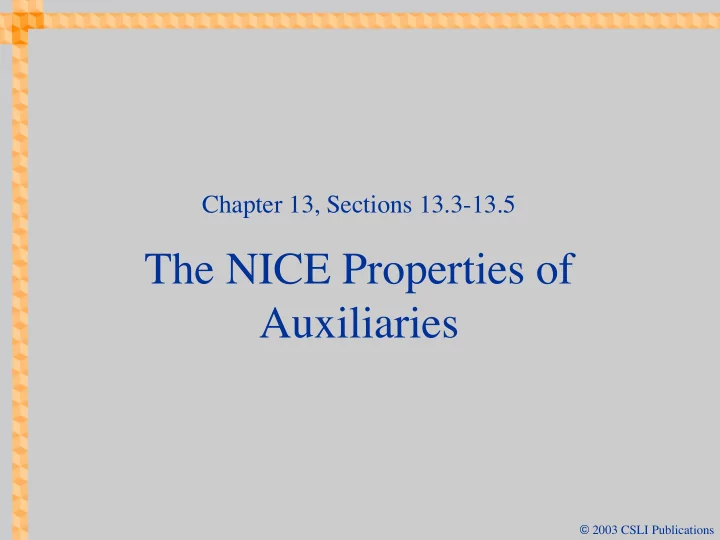

Chapter 13, Sections 13.3-13.5 The NICE Properties of Auxiliaries 2003 CSLI Publications
Our Analysis of Auxiliaries So Far • Auxiliaries are subject-raising verbs (following Ross) • Most basic distributional facts about them can be handled through ARG-ST constraints -- that is selectional restrictions between auxiliaries and their complements (following McCawley) • Auxiliaries are identified via a HEAD feature AUX, which we have not yet put to use 2003 CSLI Publications
Descriptive Summary of the NICE Properties Sentences are negated by putting not after the first auxiliary verb; they can N egation be reaffirmed by putting too or so in the same position Questions are formed by putting an I nversion auxiliary verb before the subject NP Auxiliary verbs take negated forms, C ontraction with n’t affixed Verb phrases immediately following an E llipsis auxiliary verb can be omitted 2003 CSLI Publications
Negation (and Reaffirmation) • Polar adverbs (sentential not, so, and too ) appear immediately following an auxiliary • Pat will not leave • Pat will SO leave • Pat will TOO leave • What about examples like Not many people left ? • What happens when you want to deny or reaffirm a sentence with no auxiliary? • Pat left • Pat did not leave • Pat did TOO leave 2003 CSLI Publications
The Auxiliary do • Like modals, do only occurs in finite contexts: *Pat continued to do not leave • Unlike modals, do cannot be followed by other auxiliaries: *Pat did not have left auxv-lxm � � � � FORM fin SYN HEAD verb � � � SYN HEAD FORM base � do , ARG-ST X , − AUX � � SEM INDEX s � � INDEX s SEM � � RESTR 2003 CSLI Publications
The ADV pol -Addition Lexical Rule pi-rule verb FORM fin SYN HEAD POL − � � INPUT X , AUX + � 1 � ⊕ ARG-ST A � � SEM INDEX s 1 � � HEAD POL + SYN � � � Z � VAL SPR � � ADV pol OUTPUT Y , � � INDEX s 2 � 1 � ⊕ ⊕ ARG-ST A � � � � RESTR ARG s 1 � � SEM INDEX s 2 2003 CSLI Publications
What does the type pi-rule mean? • It maps words to words (hence, “post-inflectional”) • It preserves MOD values, HEAD values as a default, and (like other lexical rule types) SEM values as a default word HEAD / 1 � � / 0 , INPUT SYN � � MOD VAL A SEM / 2 word HEAD / 1 � � / 0 , OUTPUT SYN � � VAL MOD A SEM / 2 2003 CSLI Publications
What is the role of these indices? pi-rule verb FORM fin SYN HEAD − POL � � INPUT X , AUX + � 1 � ⊕ ARG-ST A � � SEM INDEX s 1 � � HEAD POL + SYN � � � Z � VAL SPR � � ADV pol OUTPUT Y , � � INDEX s 2 � 1 � ⊕ ⊕ ARG-ST A � � � � RESTR ARG s 1 � � SEM INDEX s 2 2003 CSLI Publications
Which not s does the rule license? pi-rule verb FORM fin SYN HEAD POL − � � INPUT X , AUX + � 1 � ⊕ ARG-ST A � � SEM INDEX s 1 � � HEAD POL + SYN � � � Z � VAL SPR � � ADV pol OUTPUT Y , � � INDEX s 2 � 1 � ⊕ ⊕ ARG-ST A � � � � RESTR ARG s 1 � � SEM INDEX s 2 Andy must not have been sleeping? Andy must have not been sleeping? Andy must have been not sleeping? Kleptomaniacs cannot not steal. Kleptomaniacs cannot not steal. 2003 CSLI Publications
Which not s does the rule license? pi-rule verb FORM fin SYN HEAD POL − � � INPUT X , AUX + � 1 � ⊕ ARG-ST A � � SEM INDEX s 1 � � HEAD POL + SYN � � � Z � VAL SPR � � ADV pol OUTPUT Y , � � INDEX s 2 � 1 � ⊕ ⊕ ARG-ST A � � � � RESTR ARG s 1 � � SEM INDEX s 2 ✓ Andy must not have been sleeping? 7 Andy must have not been sleeping? 7 Andy must have been not sleeping? ✓ Kleptomaniacs cannot not steal. 7 Kleptomaniacs cannot not steal. 2003 CSLI Publications
Negation and Reaffirmation: A Sample Tree S NP VP Leslie V ADV pol VP did so eat the whole pizza 2003 CSLI Publications
Inversion • Yes-no questions begin with an auxiliary: Will Robin win? • The NP after the auxiliary has all the properties of a subject • Agreement: Have they left? vs. *Has they left? • Case: *Have them left? • Raising: Will there continue to be food at the meetings? • What happens if you make a question out of a sentence without an auxiliary? 2003 CSLI Publications
Inversion • Yes-no questions begin with an auxiliary: Will Robin win? • The NP after the auxiliary has all the properties of a subject • Agreement: Have they left? vs. *Has they left? • Case: *Have them left? • Raising: Will there continue to be food at the meetings? • What happens if you make a question out of a sentence without an auxiliary? Robin won Did Robin win? 2003 CSLI Publications
Recommend
More recommend